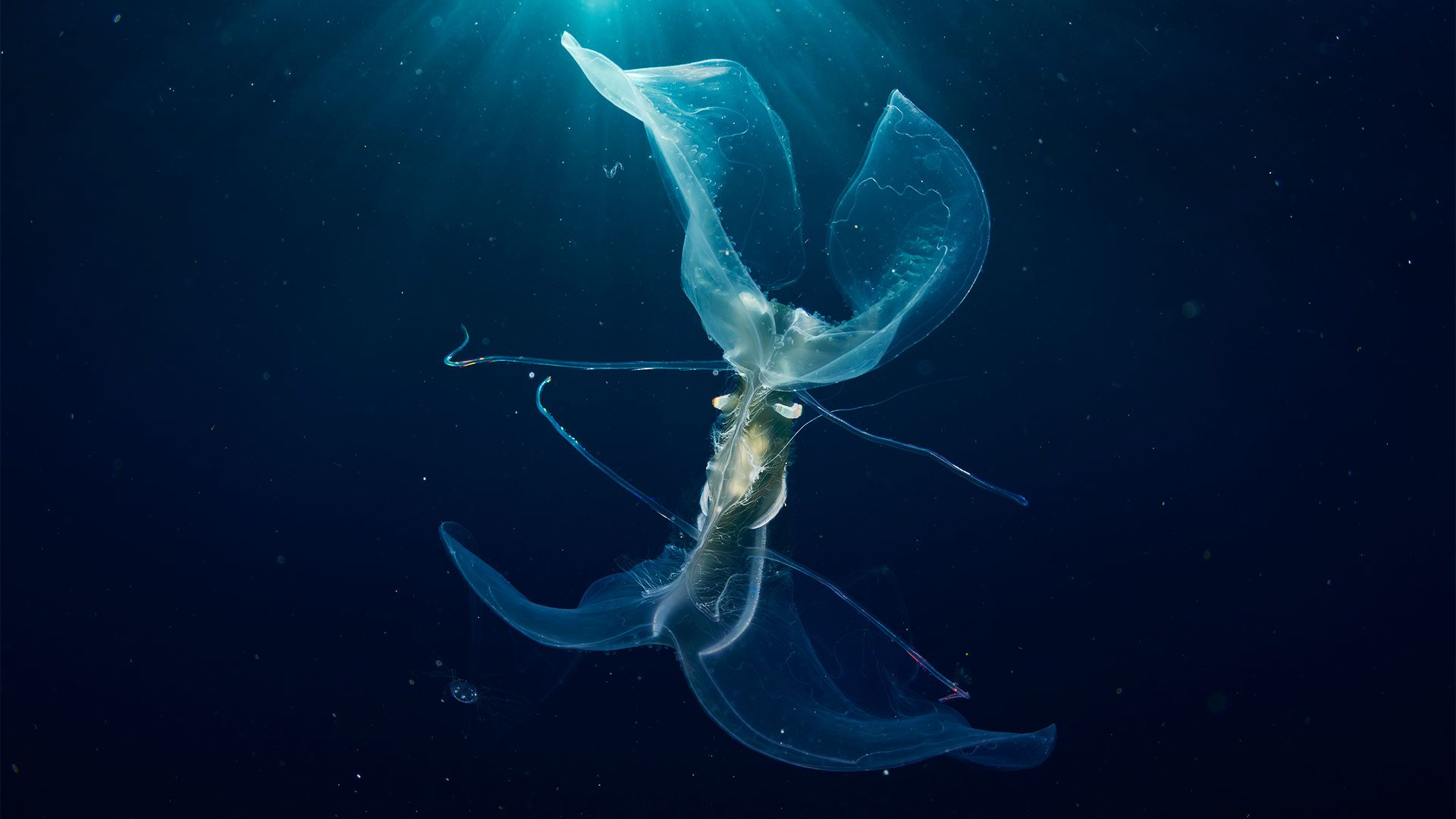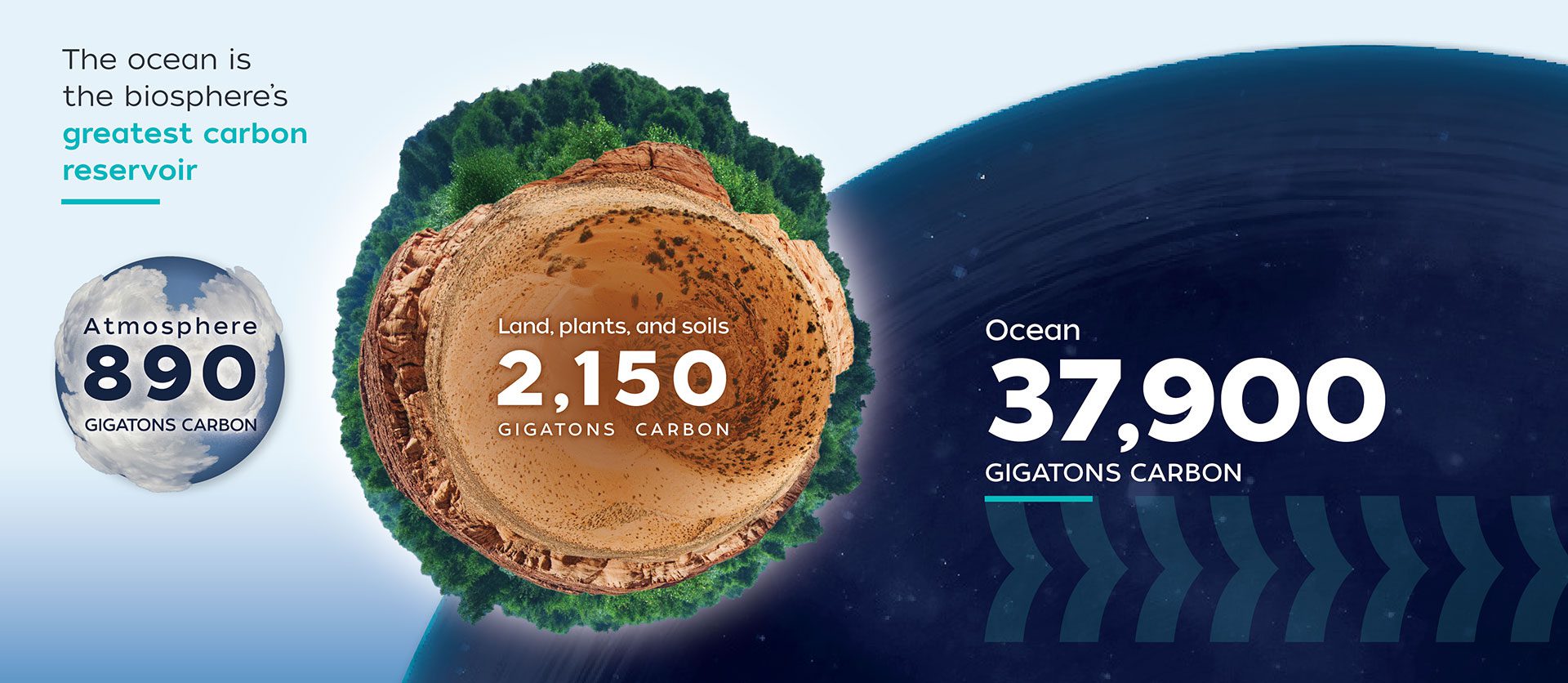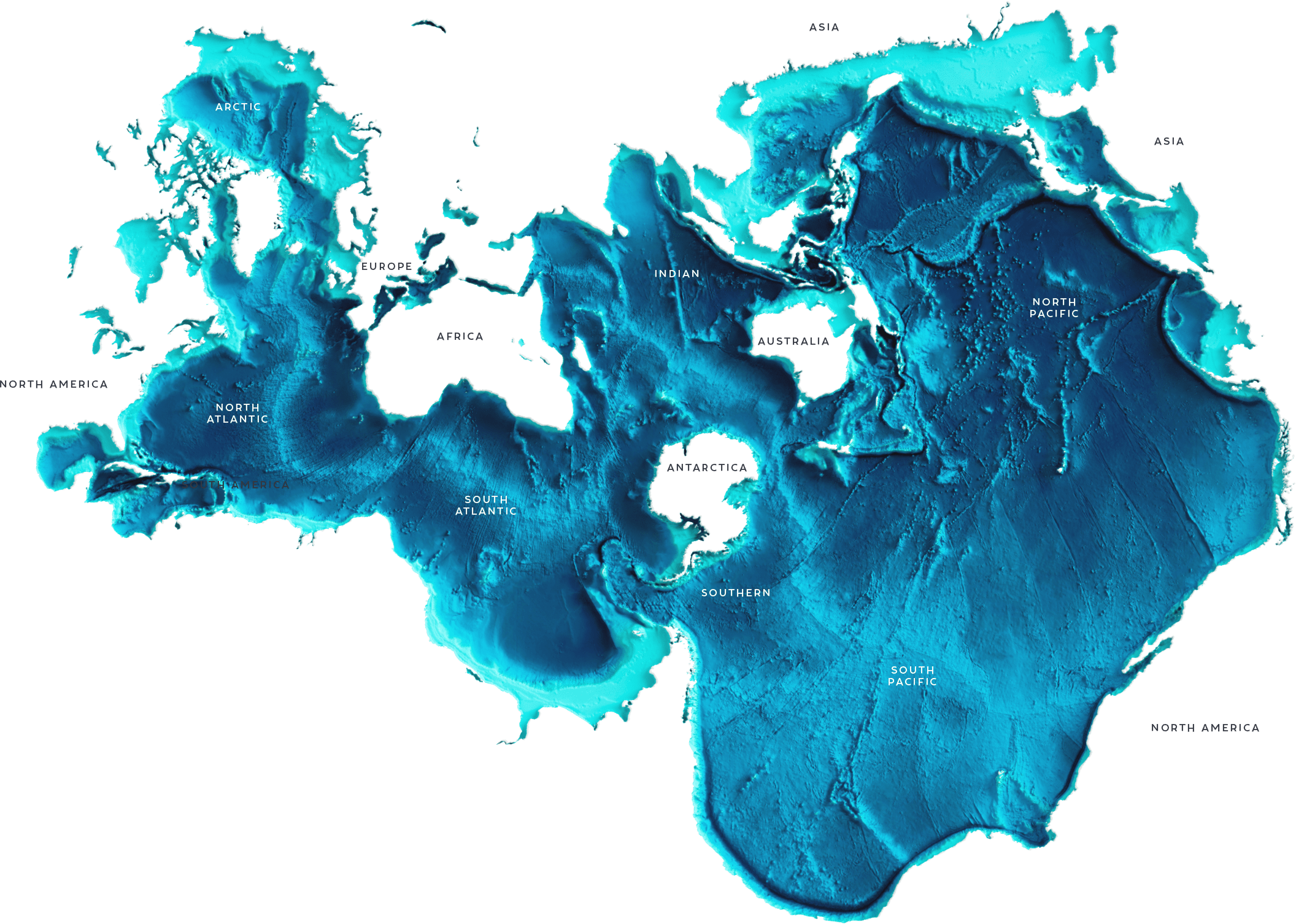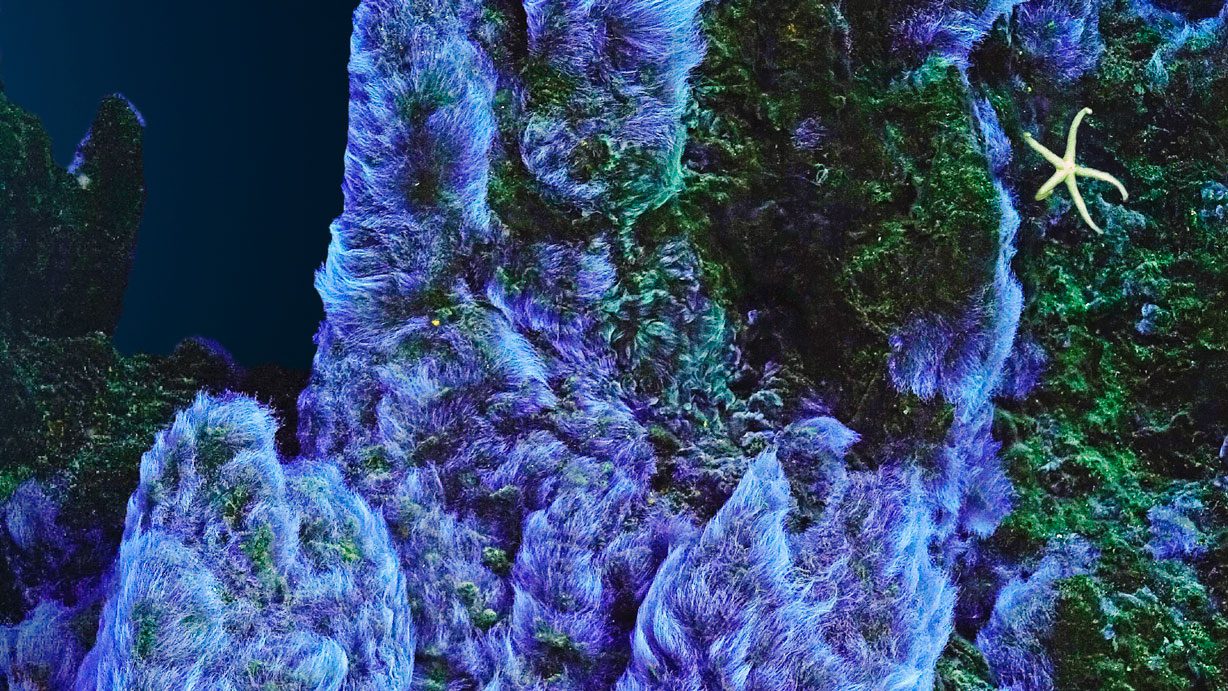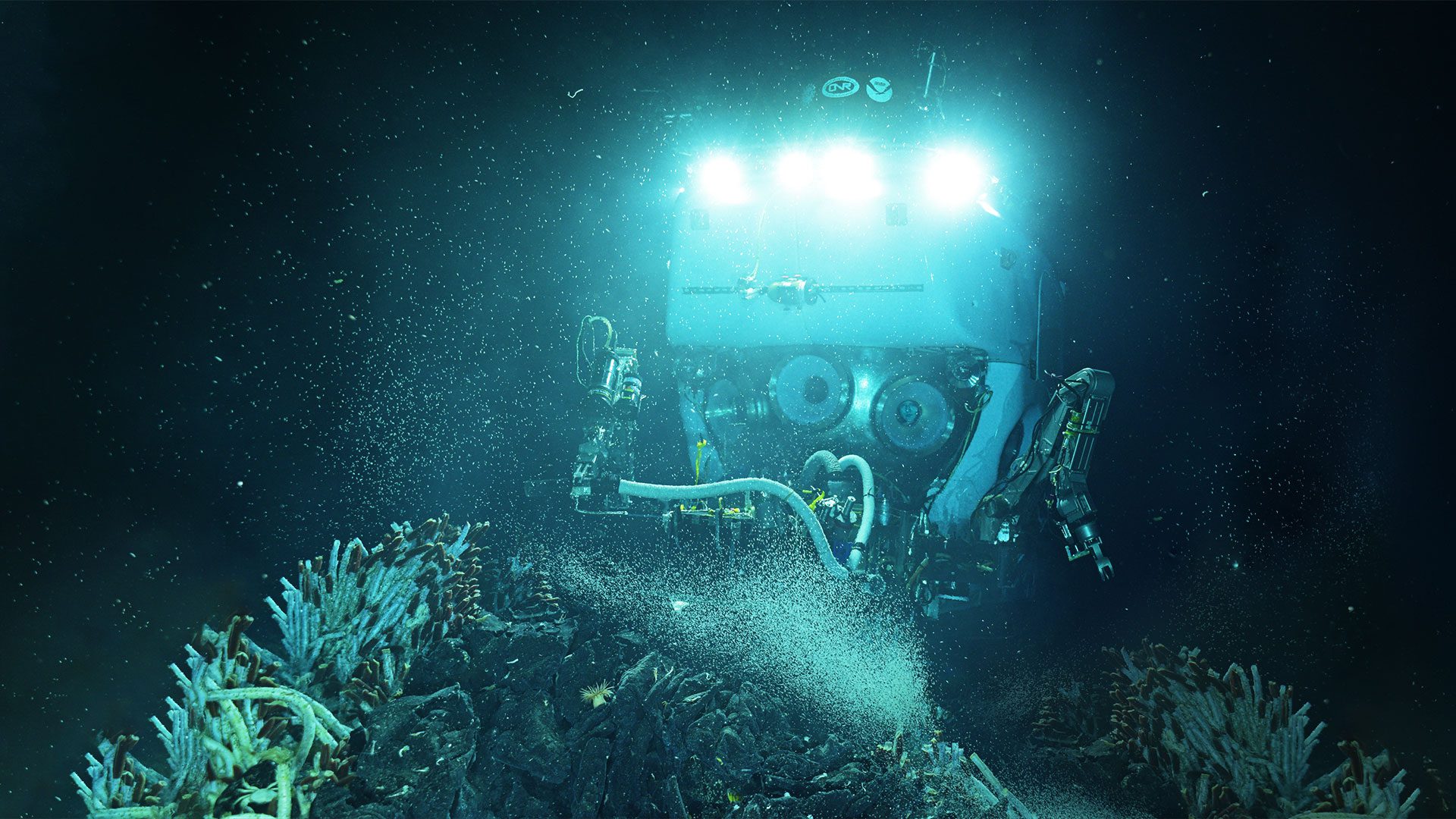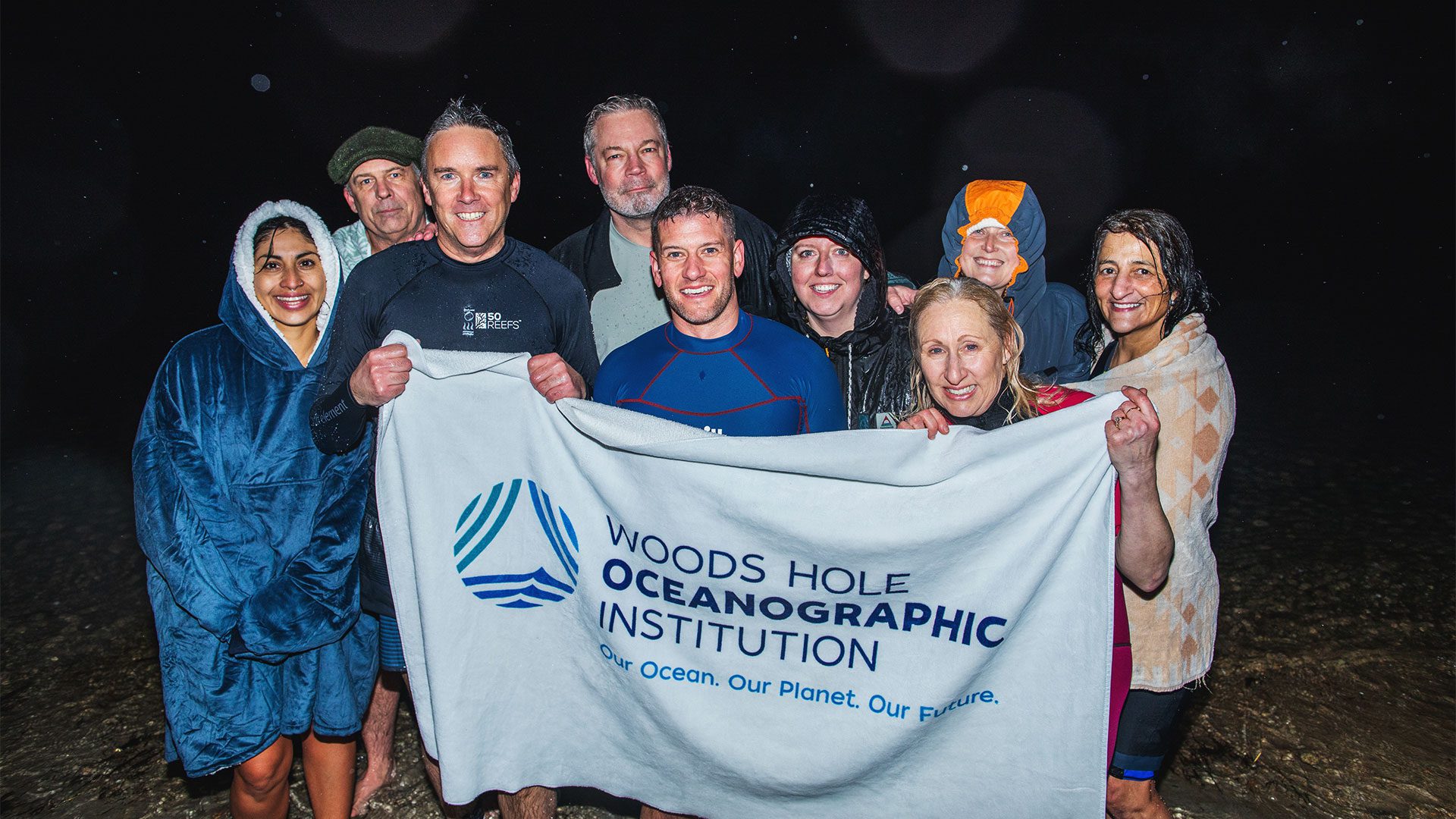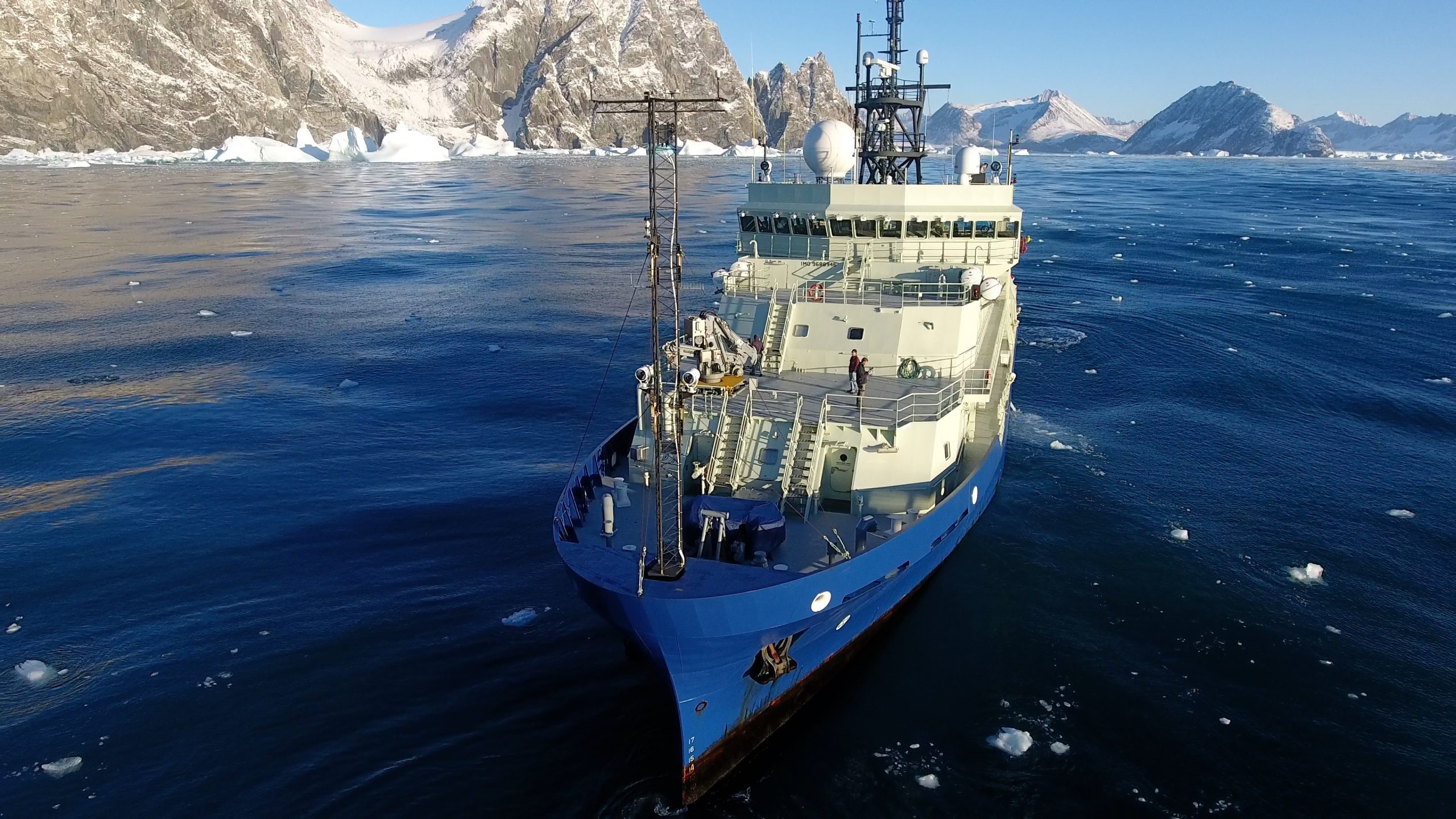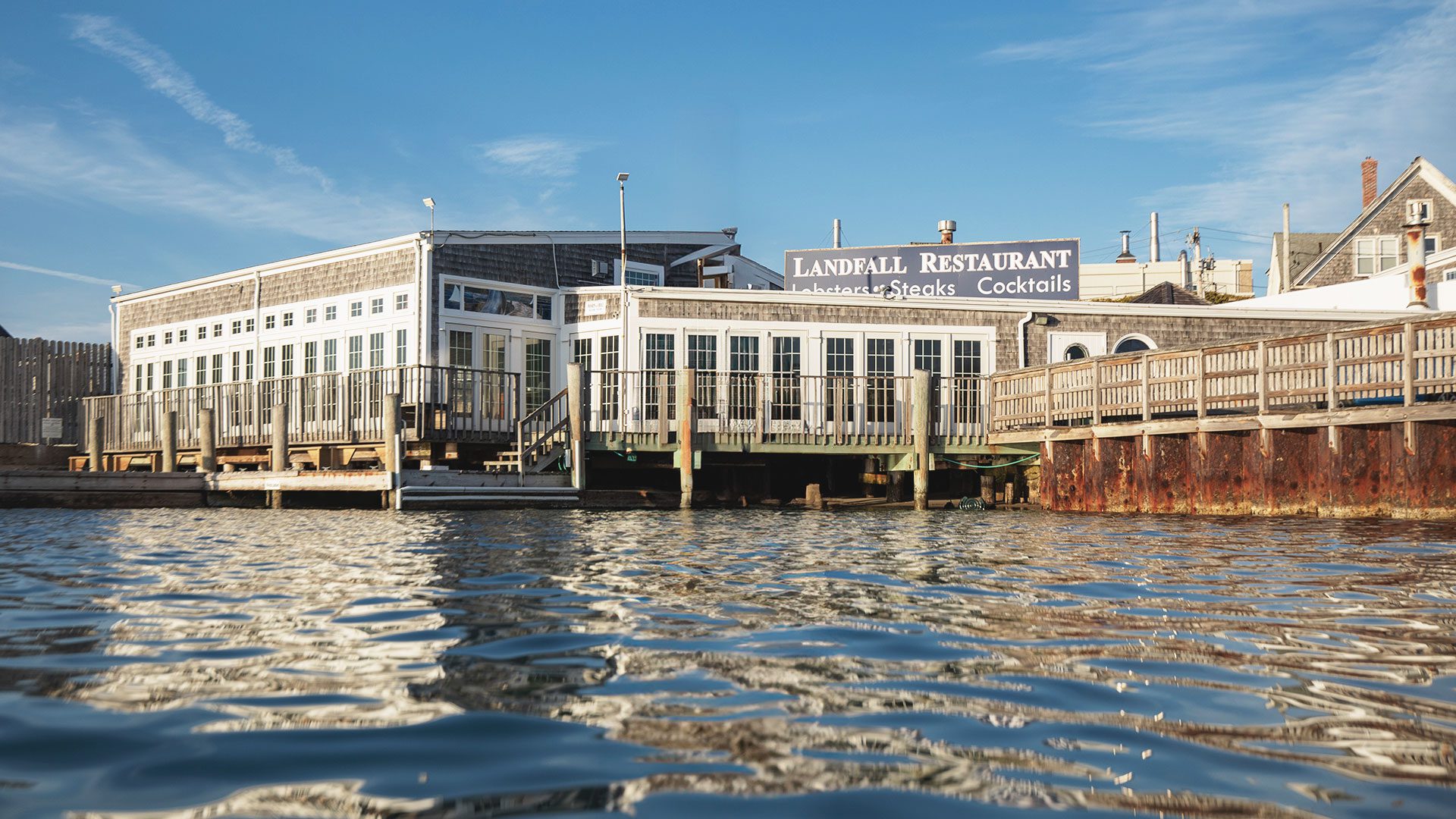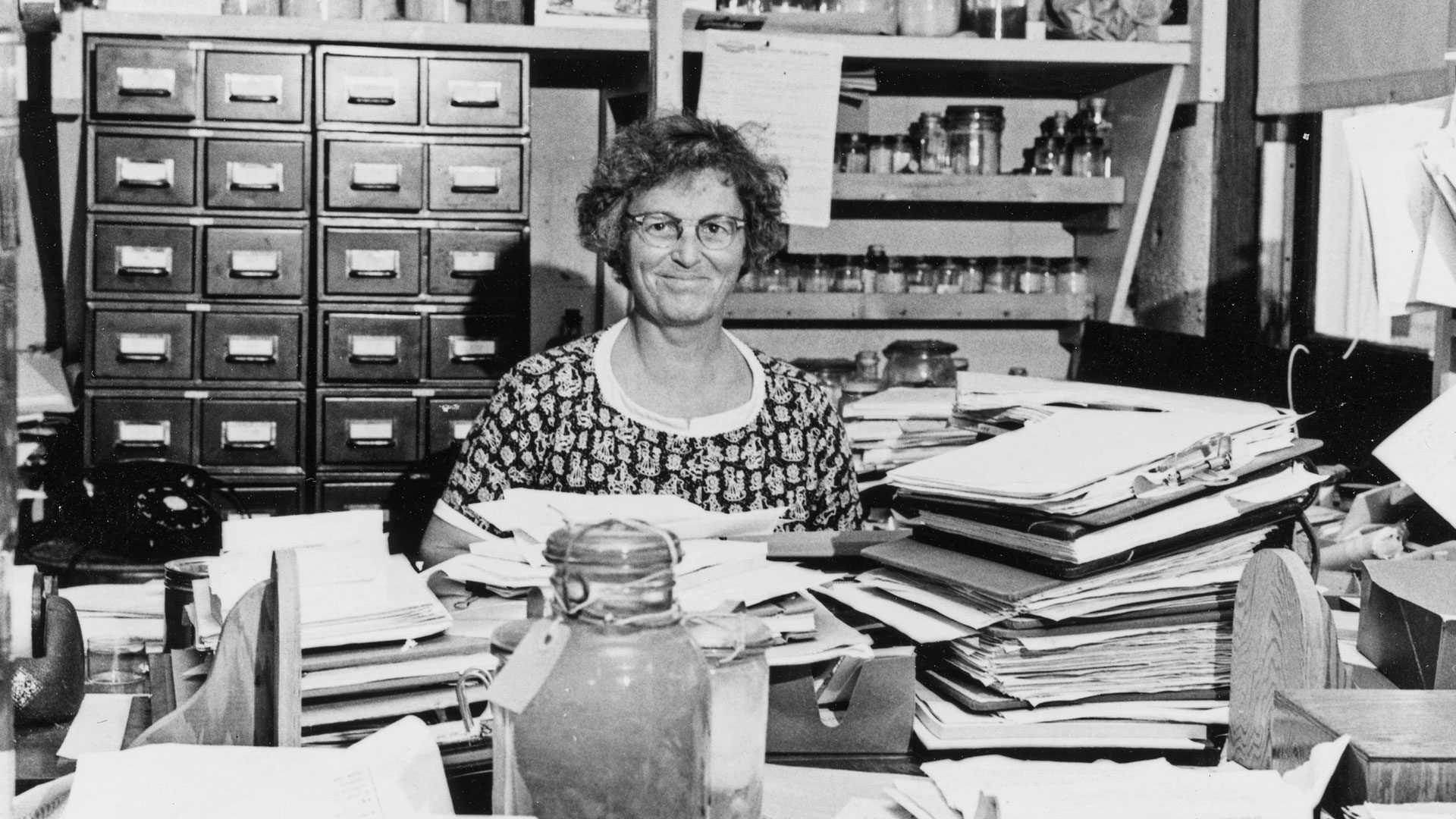
The Ocean (Re)Imagined
How expanding our view of the ocean can unlock new possibilities for life
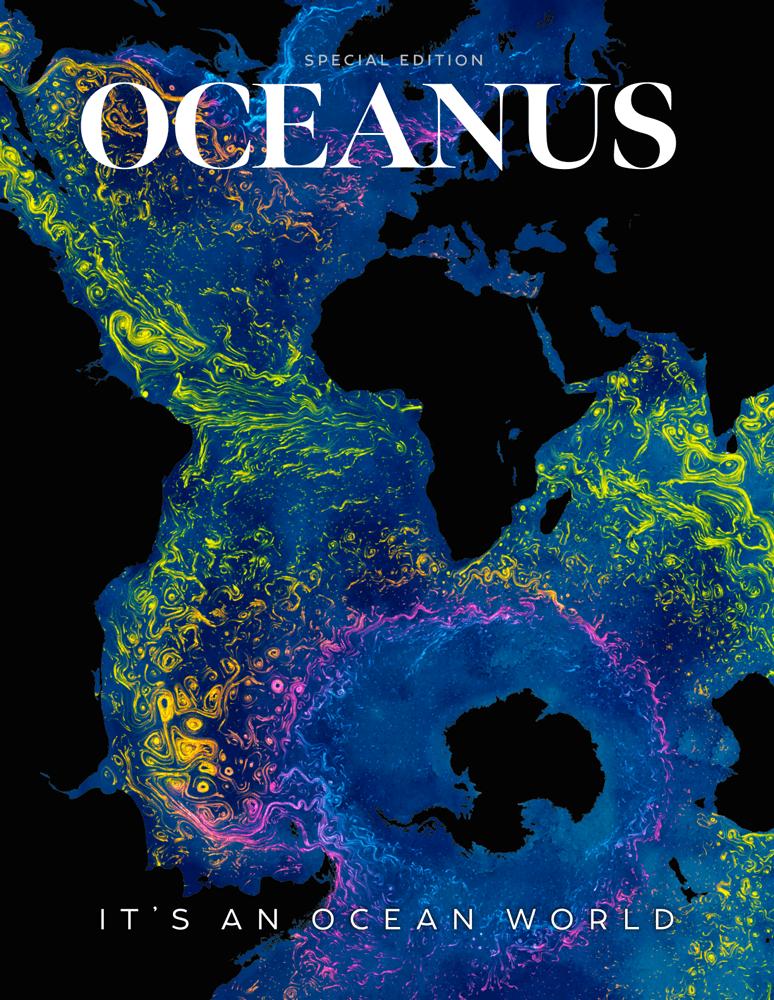 This article printed in Oceanus Winter 2025 - SPECIAL ISSUE
This article printed in Oceanus Winter 2025 - SPECIAL ISSUE
Estimated reading time: 16 minutes
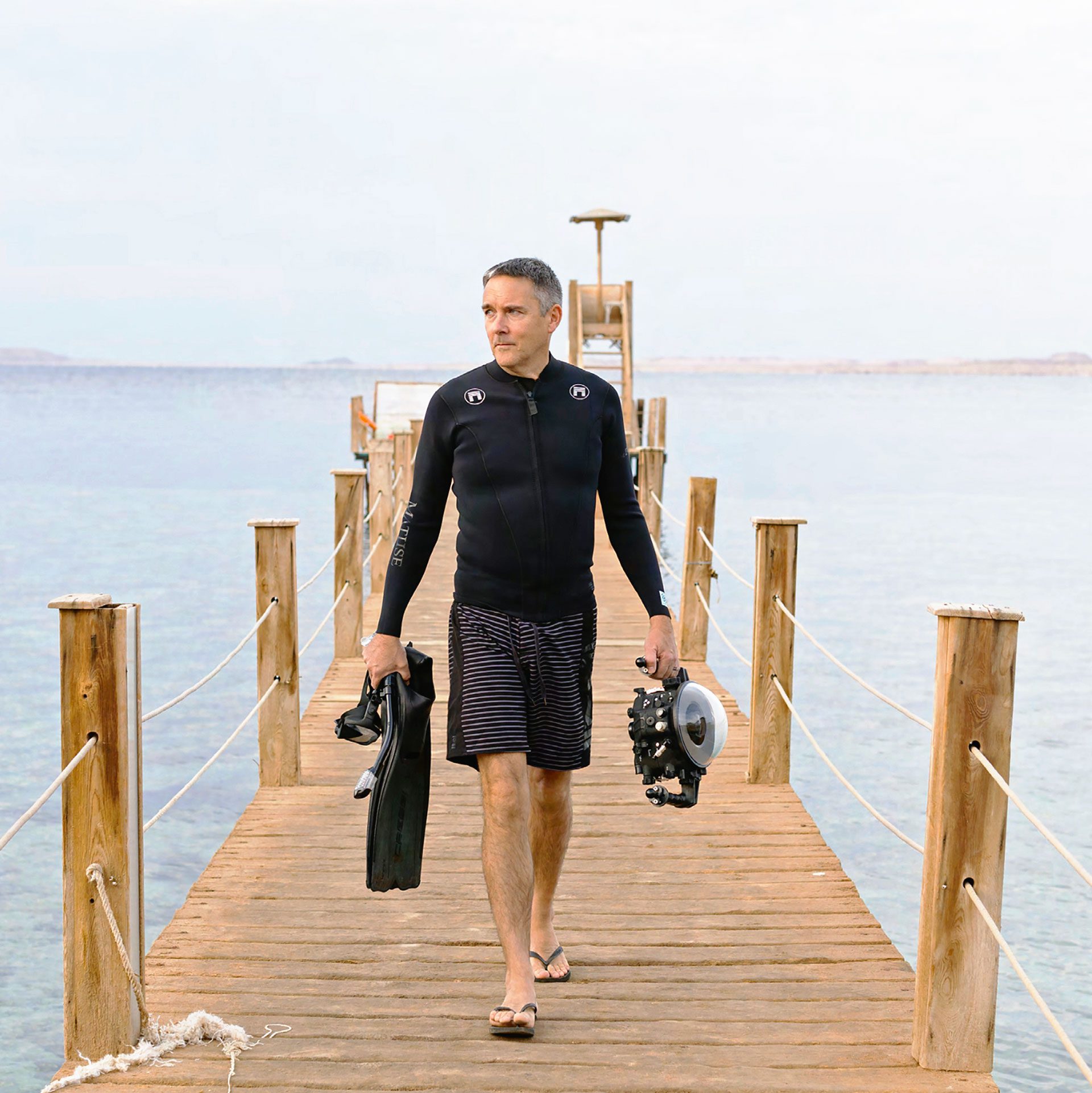
Richard Vevers (photo by Iryna Yanchukovich)
For most of his adult life, Richard Vevers believed he knew the ocean. As an accomplished underwater photographer and ocean conservationist, Vevers spent a large portion of his career photographing marine environments across the world. But it wasn’t until one particular dive off the coast of Indonesia that something clicked—a moment he refers to as his “ocean epiphany.”
As his ship traversed the deep ocean between dive sites, the horizon began to boil. A large school of fish, startled by an unseen threat, churned the distant water. Vevers and the crew gave chase, hoping to photograph the commotion, but by the time they arrived, the fish and the mysterious instigator were nowhere to be seen.
Vevers jumped in anyway. “When you’re diving,” Vevers says, “you normally don’t focus on the ocean itself. You’re too busy looking at the marine life or underwater feature you came to see.” Instead, Vevers found himself facing an open ocean: borderless, bottomless, yet pulsing with energy and tiny motes of planktonic life.
For the first time in his career, Vevers sensed that the ocean was larger, more complex, and unlike anything he had envisioned before. Had he been looking at it wrong?
A (re)introduction to our ocean
As the director of Room 71, a new initiative at WHOI aimed at reimagining how we communicate the ocean and its science, Vevers spends a lot of time finding ways to convey the complex reality of the ocean.
For Vevers, there’s one surprising challenge in relaying the majesty and mystery of the ocean. Simply put, “a lot of us think we know the ocean far better than we do,” he says. “Psychologists call it the illusion of explanatory depth.” Coined by Yale researchers in 2002, the term describes our tendency to overestimate our understanding of complex systems.
After his ocean epiphany moment, Vevers began cultivating a more expansive view of the ocean. In his eyes, there are two oceans—each remarkably different from the other. This is an idea derived from ancient Polynesian understanding of the ocean, which divided the nearshore environment from the vibrant, energy-filled waters of the open ocean. For Vevers, the first ocean is the one we often picture: the nearshore, shallow, surface-level environment filled with the usual cast of charismatic suspects—whales and dolphins, coral, and clownfish. This “transition zone” is not too dissimilar to our terrestrial world. But then there is the ocean beyond the horizon, buried beneath the waves, and far beyond our imagination. An ocean so distant and alien to our terrestrial world that it’s hard even to contemplate. One that’s alive, essential, and teeming with some of the planet’s most extraordinary life and deepest mysteries. A place most of us never even think about or realize is there.
As a deep-sea scientist at WHOI and accomplished science communicator, Julie Huber knows how surface-level our understanding of the ocean can be.
“The ocean represents over 99 percent of the habitable space on our planet,” says Huber. “It’s difficult to comprehend this huge habitable volume on our planet.”
The average depth of the ocean is ~3,700 meters, or about 12,000 feet. Imagine lying on the ground with an entire mountain of water placed on top of you. Instead of impenetrable rock, picture each point of that volume as habitable to life.
The ocean is not only spatially dominant but, at times, biologically dominant as well. Up to 78 percent of all animal biomass on Earth consists of marine life. While there are an estimated 2.5 million ants for every one human, there are 20 billion copepods. The oldest animals on Earth live in the ocean; there are glass sponges in the deep ocean believed to be over 15,000 years old.
Beyond 200 meters (~650 feet), the ocean descends into darkness—a twilight zone where sunlight fades until light no longer penetrates. Most of the ocean lies beneath this point, meaning that, on average, the ocean is black, not blue. Temperatures hover just above freezing. Photosynthesis, the driving force of energy production, no longer works. Organisms must either migrate to the surface or find novel ways to consume nutrients through deadfall or even chemosynthesis, drawing energy from hydrothermal vents and rock. In this dark abyss, most animals communicate through bioluminescence. It’s estimated that over 76 percent of all ocean species communicate this way.

One drop of ocean water
A single drop of seawater can contain millions of microorganisms, including many species of phytoplankton that are responsible for producing at least half of the oxygen we breathe. (Illustration by WHOI Creative, © Woods Hole Oceanographic Institution)
On our planet, the average “landscape,” for lack of a better word, isn’t a sunlit field or forest. It’s a dark and cold column of ocean water filled with strange, novel, and sometimes even glowing animals.
As hostile and foreign as this environment may seem, Johanna Weston, deep-sea biologist at WHOI, explains that this “alien” environment is not a novelty but the norm. It’s home for the majority of our planet. These environments are as vivid, dynamic, and biodiverse as we’d picture islands and rainforests, plains and mountaintops.
“Seventy-one percent of our planet’s surface is water, and 60 percent of that is deep ocean beneath 1,000 meters (~3,280 feet),” says Weston. “We’re not just a blue planet, but a deep planet.”
If we were to drain the ocean of its waters, we’d find mountain ranges as majestic as the Rockies. Canyons that cut far steeper than the Grand Canyon. Monuments as gnarled and awe-inspiring as the sandstone sculptures of the West. If we could see the movement of its water masses, we’d find waterfalls over a thousand times bigger than Niagara’s cascading over undersea cliffs.
Add every river in the world—the Amazon, the Mississippi, the Nile, the Seine—throw in every little creek, stream, and roadside ditch you’ve ever come across, and you’d only get to ~1/75th the peak flow of the Gulf Stream. You can fit five moons across the belly of the Pacific and have room to spare. On the International Space Station, there are points in orbit where astronauts only see blue.
Despite the centrality of the ocean’s role in terrestrial systems—the ocean drives global heat and weather, carrying moisture that determines drought or deluge; it sustains fisheries that feed billions; it influences economies, borders, and the stability of nations—we often oversimplify our mental picture of the ocean, contends Vevers. By treating it like a known and familiar quantity, we fail to see the complexity and scale of this “second” unseen ocean. We devalue not only the ocean’s magnificence, but its sheer potential.
To meet the challenges of the future, from climate mitigation and decarbonization to food security, sustainable development, and human health, we’ll need to unlearn our surface-level assumptions about the ocean and embrace the complexity of its deepest, distant, and most unique parts.
Truly seeing, understanding, and investing in the ocean may be one of the most important things we can do.
Depths of possibility
For Peter de Menocal, president and director of WHOI, “the ocean is not just a resource to be managed but a frontier of opportunity we’re just beginning to discover.”
Like the ocean’s scale and depth, the scope of oceanographic research can be hard to fully comprehend, spanning everything from climate mitigation to the very nature of our DNA.
Take the driving challenge of our time: our changing climate, de Menocal explains. The latest Intergovernmental Panel on Climate Change (IPCC) Assessment Report, released in 2023, notes that carbon dioxide removal is necessary to limit climate change to 1.5°C (2.7°F). The ocean’s vast capacity for absorbing carbon dioxide, through natural processes and emerging technologies, positions it as a critical component of any global strategy to remove excess carbon from the atmosphere. The ocean’s immense scale and depth—the very barriers to our conceptual understanding—may prove to be “our greatest allies” in climate mitigation efforts ahead, de Menocal says.
“As a carbon reservoir, the ocean has more than 40 times the amount of carbon as the atmosphere,” says de Menocal. “If we wanted to remove all the excess carbon added to the atmosphere by human emissions since the start of the Industrial Revolution, it would increase the ocean’s carbon reservoir by just 1 percent. It’s quite literally a drop in the ocean.” Removing that excess CO2 is “something that can happen in a lifetime.”
Many of our boldest carbon dioxide removal efforts “come from looking at the way the ocean deals with carbon on really long time scales,” says Sophie Hines, paleooceanographer at WHOI. Exploring how our planet stores carbon now and how it has in the distant past can lead to novel ways of handling the excess atmospheric CO2. “People have used that understanding [of the carbon cycle] to think about how we can speed these processes up.”
Ocean-based solutions to carbon dioxide removal and alternative energy don’t dominate the zeitgeist relative to terrestrial solutions, yet by some reports, these solutions can deliver up to 35 percent of the annual greenhouse gas emission reductions needed by 2050 to limit global temperature rise to 1.5ºC (2.7ºF). Salps—a jellyfish-like species and contributor to the ocean’s biological carbon pump—export, by some models, 700 million metric tons of carbon to the deep sea each year. That’s equal to emissions from more than 150 million cars. Large-scale efforts at WHOI are currently underway to study climate solutions like ocean alkalinity enhancement, iron fertilization, seaweed cultivation, and blue carbon restoration—all of which could enhance the ocean’s natural ability to take up and store carbon.
Caution, however, is essential to executing these ambitious climate mitigation efforts. “We have to understand what the efficacy is, and the durability of the storage is, but principally what the ecosystem and ocean health impacts are, and whether it’s a net positive, negative, or neutral,” says de Menocal.
But climate isn’t the only frontier where a reimagining of ocean science is breaking new ground. Our mimicry of the ocean’s biological, geochemical, and physical processes is also driving breakthroughs in fields as diverse as medicine, public health, food security, and resource management. From fisheries forecasting to cutting-edge Alzheimer’s and cancer research, the ocean’s influence extends deep into the systems that sustain human life, often in ways we scarcely recognize.
Change your perspective
In 1942, Athelstan Spilhaus—a scientist and inventor at Woods Hole Oceanographic Institution—had a bold idea: What if we drew our world map with the ocean at its center? After all, Earth is an ocean world, despite its misleading name. Spilhaus believed our world maps would be more accurate—and more honest—if they weren’t based on a worldview centered around the city of London, home to many English cartographers whose depictions of Earth still influence global charts today. The ocean connects us all. It defines our planet and makes life possible through its unique and extraordinary nature. It’s what belongs at the center of our world, not London or any other city, for that matter.
Neel Aluru, associate scientist at WHOI, is no stranger to how ocean research bleeds into the realm of human health and medicine. His work explores the connection between environmental exposures and human health outcomes by studying how marine toxins impact the developing brain. “One thing that is important for people to understand is just how everything comes together,” says Aluru, even across seemingly distant and disconnected realms of science.
Oceanographic exploration, Aluru points out, has quietly yielded some of humanity’s most transformative medical and scientific breakthroughs. Enzymes from deep-sea organisms have revolutionized DNA analysis by enabling the polymerase chain reaction (PCR), a technique that facilitates the rapid replication of specific DNA segments for testing. PCR, as many recall, was a key component in COVID-19 testing. Limulus amebocyte lysate (LAL), a reagent derived from horseshoe crab blood, is the gold standard for detecting bacterial contamination in injectable medicines and medical devices. WHOI scientist Stanley Watson played a key role in refining and scaling the reagent for pharmaceutical use. His work on improving sensitivity and extraction helped bring LAL testing to the global stage, saving millions of lives worldwide.
Despite the depth of our oceanographic knowledge (no pun intended), the ocean is still very much a frontier. A recent study published in the journal Science estimates we’ve visibly seen .001 percent of the deep ocean—a space roughly equivalent to the size of Rhode Island. Scientists have mapped only 26 percent of the sea floor at high resolution, and researchers estimate that 80–90 percent of the 1-2 million species believed to live in the ocean remain unidentified.
For Amy Bower, senior scientist and physical oceanographer at WHOI, “The secondary effect and indirect benefits [of oceanographic research] are very hard to get across.” Exploring, mapping, cataloging, and monitoring these waters would trigger cascading impacts that revolutionize life on our planet, drive discoveries, and give us the knowledge and insights to become better stewards of our planet.
Oceanographic research can be a hard sell to general audiences, partly due to our terrestrial biases, but partly because the downstream benefits aren’t apparent at first glance. It can be hard to draw a thread from floats measuring temperature and salinity in the Pacific to our national security, but that connection is there (the speed of sound in water, dictated by temperature and salinity, is crucial to submarine detection and stealth). It’s easy to dismiss ocean research in isolation—why send a crew to study a deep-sea microbe? In the same way we often oversimplify our conceptualizations of the ocean, we also fail to grasp the unseen depths and interconnectedness of scientific research. Among a bevy of things, deep-sea microbe research is a foundational part of humanity’s race against antibiotic resistance.
WHOI leads the way
While the ocean may be our most significant source of discovery and hope in the years ahead, there’s no doubt it’s in crisis right now as climate change, pollution, overfishing, and other anthropogenic factors intensify threats to ocean ecosystems. We face a critical moment in both our study and stewardship of these waters. Despite the untapped potential of the field, ocean science faces limited funding relative to peer fields—a problem exacerbated by recent federal cuts to national science funding.
“When you economize science, you diminish your future,” says Bruce Strickrott, Navy Veteran and group leader for Alvin, WHOI’s deep-sea human-operated vehicle. When science funding and research are reduced solely to short-term economic considerations, limited to immediate returns, or seen only through a narrow cost-benefit lens, we lose sight of the long-term, transformative, and often serendipitous discoveries that science brings.
Upon taking the helm of WHOI in 2020, de Menocal and his colleagues settled on a word to define the next decade of work at the institution. That word was “courage.” Courage to pursue the biggest questions facing humanity. Courage for the institution to lead. Courage to meet the moment and the daunting challenges ahead.
In the face of the challenges and shifting scientific landscape, de Menocal remains resolute in the mission and potential of ocean sciences and WHOI’s role in advancing that work.
“What sets WHOI apart—our ‘X-factor’—is not just the size and excellence of our scientific staff,” says de Menocal. “It’s the fact that, for every scientist, we also have about three technicians and engineers whose creativity, experience, and dedication fuel breakthrough advances in ocean sensing, observation, and monitoring.”
Ocean science is far more interdisciplinary compared to terrestrial-based sciences. In the ocean, the borders between biology, physics, engineering, chemistry, and geology are thin. How do you divide biology, geology, engineering, and chemistry when microbes draw energy directly from the chemicals of stone; when observations require tools to survive environments more hostile than the vacuum of space? Unlocking the ocean’s complexity requires a full suite and synthesis of disciplines—the best marine minds all under one roof, supplied with the resources of engineering and ocean access. WHOI is one of the only institutions worldwide that can blend science, engineering, and ocean accessibility.
For de Menocal, the ocean holds the answers to the most significant questions facing our planet at the moment. “That’s the part that still keeps me really excited, and frankly, just incredibly motivated to continue the work that we’ve been doing at WHOI,” he says.
“The problems haven’t gone away,” says de Menocal. “They’ve just become harder to solve. We’re leaning into them at WHOI today.” With courage as the guide, the way forward remains clear.
Even a single oceanographic project, piece of equipment, or expedition can unlock insights that ripple through disciplines. Alvin, for example, has completed over 5,200 dives and has directly contributed to thousands of scientific papers. Its dives have reshaped our understanding of deep-sea ecosystems, hydrothermal vents, and microbial life, revealing worlds and life forms that we never knew existed throughout human history. As new technologies and monitoring networks come online, humanity will be able to push deeper and further into our ocean’s physics, biology, chemistry, geology, and more.
“To care about something, you have to love it,” says de Menocal. “To love it is to understand it.”
To truly understand and care about the ocean—its scale, its complexity, its influence—is to reimagine it not as something apart from us but as an integral part of our world and future. The ocean is not just a resource to be managed. Rather, it is an unexplored frontier where the answers to humanity’s greatest questions can be found.
Toward an ocean epiphany
“It’s normal not to know the ocean,” says Vevers.
Even for oceanographers, it’s hard to convey the litany of the ocean’s impact. Where do you begin to tell a story when scale is both microscopic and planetary? When the wonders bleed into a thousand different facets? When relevant timescales take place over days, weeks, centuries, and millennia? When its depths and movement are beyond any scale we can imagine and lack any terrestrial equivalent.
But even in the most distant and unexpected corners of our planet, you can find a thread back to the ocean if you know where to look. On this planet, all stories are ocean stories. Even yours.
Still, the story of our ocean is difficult to tell. When the words fail, when the images and metaphors don’t seem to convey space and awe, sometimes it’s easier just to drag people down to the water and show them.
On a cold, rainy night in late February 2025, Vevers led a small group of people down to the water’s edge in Woods Hole. The water was black—pitch black—and hovering just below 38°F (3.3°C). Perfect, he thought. A chance “to experience the average temperature and the blackness… the ocean’s true nature.”
Two by two, they ran into the water. Muscles cramped. Lungs recoiled at the shock. In their brief moments submerged, Vevers had urged everyone to open their eyes, knowing they’d find only darkness, but hoping within that darkness they’d find a sense of the greater ocean whole. And perhaps, with it, a sense of hope about the ocean’s potential.
Who knows exactly what each person felt as they emerged from the water? The profound is often personal. Awe is not something easily elicited or conveyed. But as each participant raced, cold and wet, toward the safety of shore, Vevers could see they were smiling.
